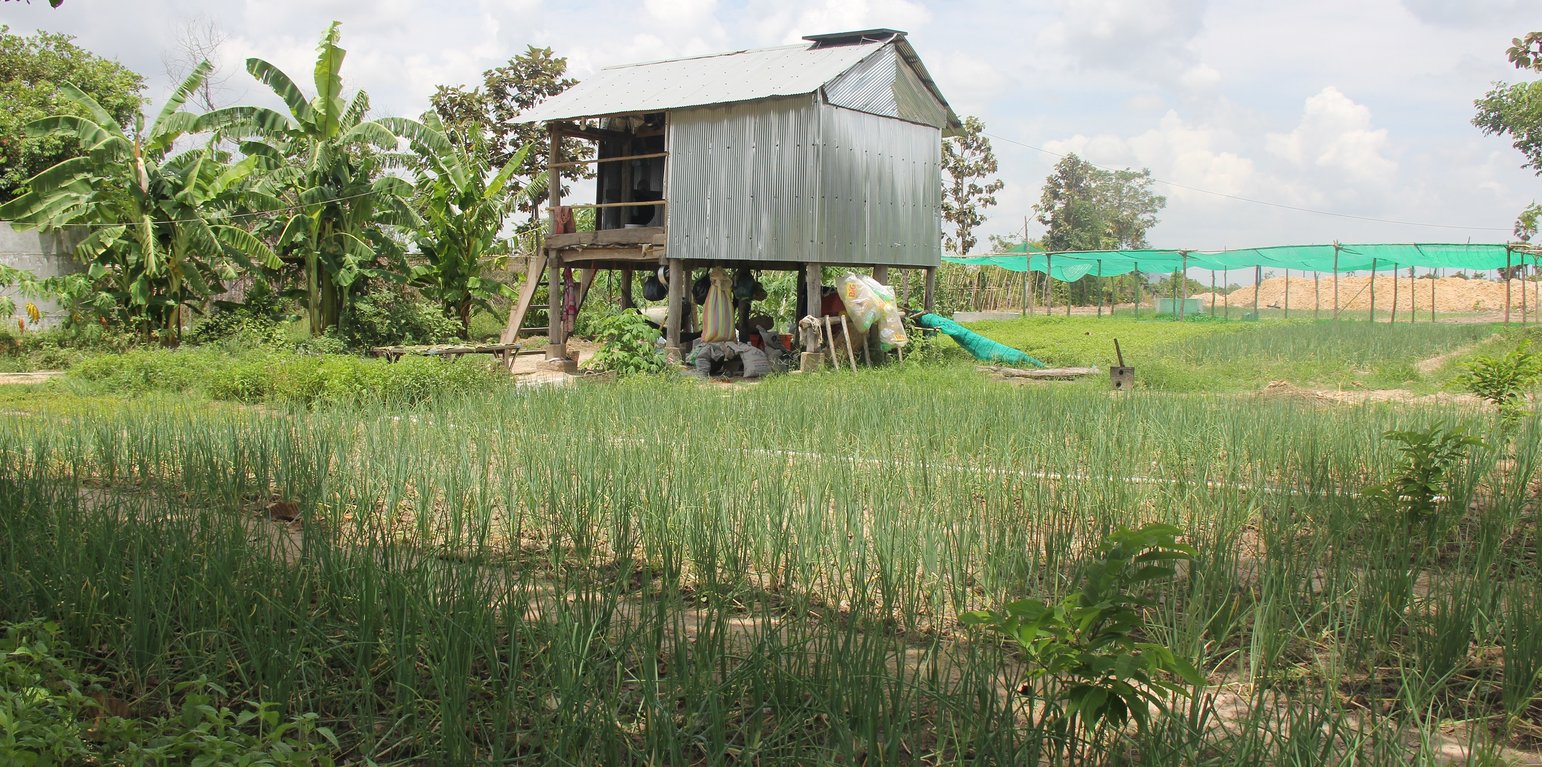



Crop diversification entails simultaneously growing two or multiple varieties of crops in a particular place with the application of crop rotation techniques and/or intercropping. The selection of the crop varieties will depend on the purpose of the land user. In general, a diversity of crops will provide a range of benefits such as food security, nutritional diversity, income generation, soil conservation, pest and disease control as well as adaptation to climate change (CGIAR, 2017, Makate et al, 2016, MoEYS& VVOB Cambodia, 2013).
Mrs. Prum Thon has been cultivating a diversity of crops with the application of rotation techniquesfor about 10 years, which involves exchanging an entire crop in a particular row. This means that cultivation can take place throughout the year without having to leave the land fallow. At the time of the interview eleven different crops had been cultivated including spring onions, anise basil, Cambodian mint, bok choy, choy sum, escarole, mint, long beans, cucumbers, bitter melons and lettuce. Almost all of these crops have an average lifespan of three months, except for the anise basil which can grow for one or two years depending on the way it is cultivated. After she has harvested a particular crop, she will then rotate this crop row with a new distinctive crop species. For instance after having harvested spring onions she will then plant mint in that row, and in the row where she was previously growing mint, she will rotate that with either spring onions or cucumbers.
The practice of crop diversification whilst at the same time rotating the crop in each of the rows aims to achieve the following main objectives:
Crop diversification enables the farmer to generate a daily income to offset her daily expenses which thereby becomes a means of improving her livelihood. Growing a diversity of crops can also enable her to meet a variety of market demands and generate a high daily income. If a farmer grows only one crop specie she can usually earn about 15,000 Riel per day, but if she plants four crop species such as anise basil, bok choy, long beans and cucumbers she can increase her income to about 20,000 Riel per day, However if she grows one more specie such as lettuce or grows eleven different crops, she would be able to increase her income up to 40,000 or 80,000 Riel per day. The practice of crop diversification enables her to generate an income on a daily basis.
Crop diversification with the rotation of the crop in each row after the harvest could assist in reducing soil degradation. According to her experience and observations each crop absorbs different nutrients from the soil. If one row is repeatedly used to cultivate spring onions, they tend not to flourish so well and the roots have a tendency to decay. However if they are rotated with another crop and the spring onions are then grown in another row, they are able to thrive and the roots and stems are less likely to spoil. Crop diversification also has other functions as the cover crops help to reduce soil degradation through expose to sunlight, maintain soil moisture, make the soil less compact and add beneficial micro-organisms to the soil. In addition crop diversification can control pests especially the practice of growing companion plants such as herbs or spring onions as this can prevent crops from being damaged by pests.
The use of this technology assists in improving livelihoods, reduces migration because she does not need to move in order to find a job in another location, and enables her to generate a daily income. In addition this technology is able to reduce the risk of crop failure resulting from damage by pests and insects.Furthermore it reduces the risks associated with changes in market demand as the farmer produces a diversity of crops and also it prevents and reduces soil degradation. In order to effectively use this technology there needs to be sufficient water supply such as a river, stream, well or pond.This enables the land user to grow crops throughout the year round and reduces damage of crops as the result of unpredictable adverse climate conditions such as changes in rainfall, or the occurrence of drought.
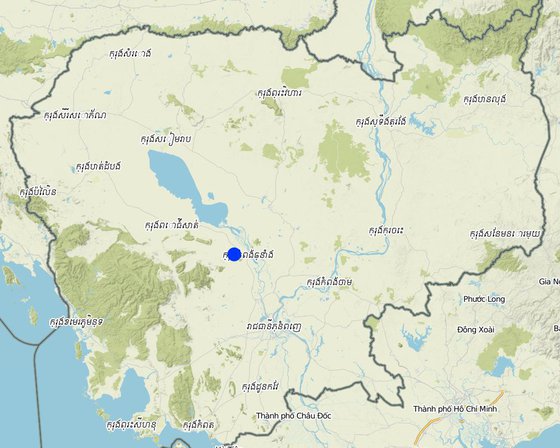
地点: Ruessei Duoch village, Banteay Peal Commune, Rolea B'ier District, Kampong Chhnang Province., 柬埔寨
分析的技术场所数量: 单一场所
技术传播: 均匀地分布在一个区域 (0.0027 km²)
在永久保护区?:
实施日期: 10-50年前
介绍类型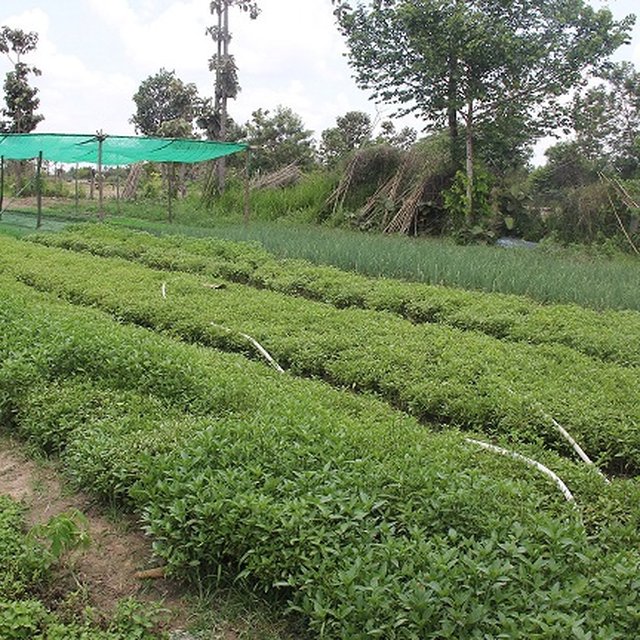
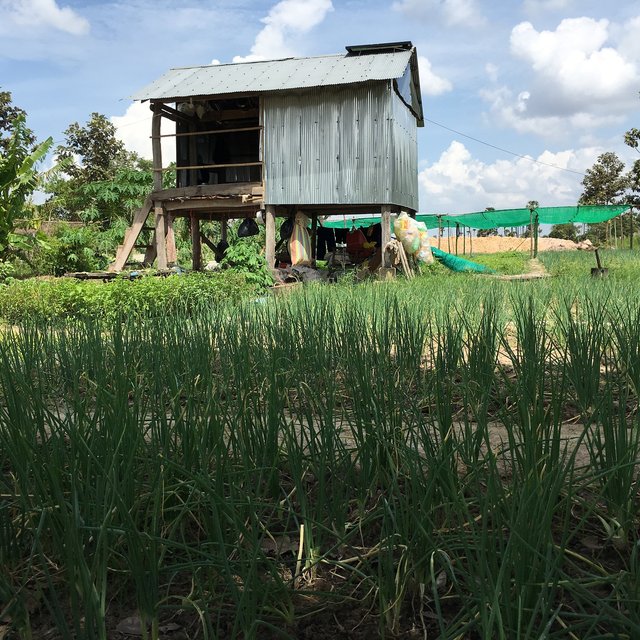







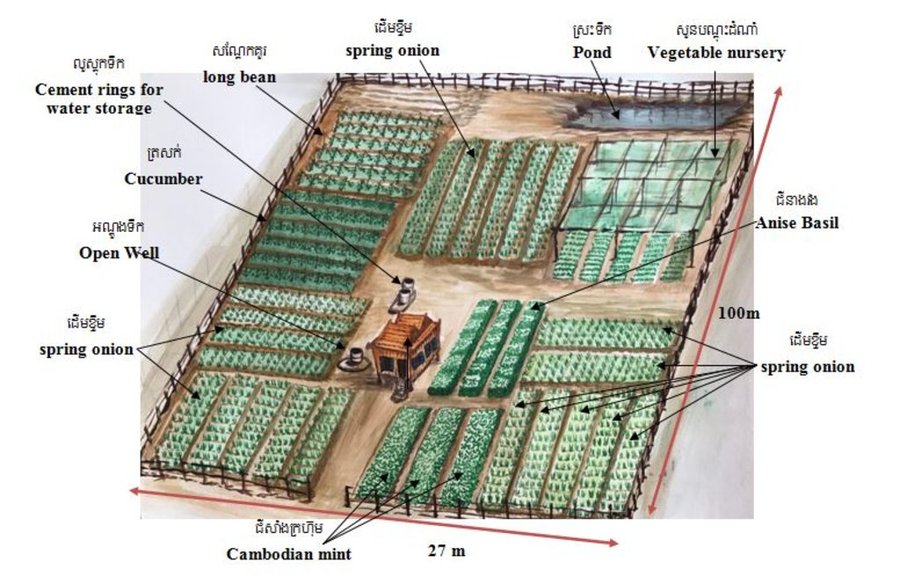
| 对投入进行具体说明 | 单位 | 数量 | 单位成本 (KHR) | 每项投入的总成本 (KHR) | 土地使用者承担的成本% |
| 劳动力 | |||||
| Plough the soil for the first and second time | person-day | 11.0 | 15000.0 | 165000.0 | 100.0 |
| Clear land for growing 11 different crops | person-day | 15.0 | 15000.0 | 225000.0 | 100.0 |
| Dig the open well and put the cement ring | person-day | 84.0 | 15000.0 | 1260000.0 | 100.0 |
| Dig pond | person-day | 133.0 | 15000.0 | 1995000.0 | 100.0 |
| 设备 | |||||
| Bamboo sticks | Piece | 50.0 | 1500.0 | 75000.0 | 100.0 |
| Hoe | Piece | 2.0 | 17000.0 | 34000.0 | 100.0 |
| Spit | Piece | 2.0 | 1300.0 | 2600.0 | 100.0 |
| Handle basket to carry soil | Pair | 1.0 | 6000.0 | 6000.0 | 100.0 |
| 植物材料 | |||||
| Spring onion | Kilogram | 10.0 | 1000.0 | 10000.0 | 100.0 |
| Bok choy | Can | 12.0 | 1500.0 | 18000.0 | 100.0 |
| Escarole | Package | 2.0 | 10000.0 | 20000.0 | 100.0 |
| Choy Sum | Can | 5.0 | 1500.0 | 7500.0 | 100.0 |
| Anise basile | Package | 1.0 | 15000.0 | 15000.0 | 100.0 |
| Mint | Kilogram | 3.0 | 4000.0 | 12000.0 | 100.0 |
| Cambodian mint | Kilogram | 2.0 | 2500.0 | 5000.0 | 100.0 |
| Long bean | Kilogram | 1.0 | 60000.0 | 60000.0 | 100.0 |
| 肥料和杀菌剂 | |||||
| Buy cow manure for the use of one year | Two wheel handle tractor | 10.0 | 70000.0 | 700000.0 | 100.0 |
| Buy chicken manure for the use of one year | Bag | 20.0 | 4000.0 | 80000.0 | 100.0 |
| Buy soil of termite mounds | Two wheel handle tractor | 10.0 | 40000.0 | 400000.0 | 100.0 |
| Buy botanical pesticides | Liter | 6.0 | 4000.0 | 24000.0 | 100.0 |
| Rice husk | Bag | 30.0 | 1500.0 | 45000.0 | 100.0 |
| Buy Bat manure for soil preparation | Bag | 5.0 | 70000.0 | 350000.0 | 100.0 |
| 施工材料 | |||||
| Water Pumping Machine | Piece | 2.0 | 880000.0 | 1760000.0 | 100.0 |
| Cement rings which also have a cement base that have been constructed for water storage to irrigate crops. | Piece | 2.0 | 70000.0 | 140000.0 | 100.0 |
| Net for making the roof to prevent sunlight and water. | Set | 2.0 | 220000.0 | 440000.0 | 100.0 |
| 其它 | |||||
| Cucumber | Can | 1.0 | 40000.0 | 40000.0 | 100.0 |
| Lettuce | Package | 5.0 | 15000.0 | 75000.0 | 100.0 |
| Bitter melon | Package | 2.0 | 5000.0 | 10000.0 | 100.0 |
| 技术建立所需总成本 | 7'974'100.0 | ||||
| 技术建立总成本,美元 | 1'993.53 | ||||
| 对投入进行具体说明 | 单位 | 数量 | 单位成本 (KHR) | 每项投入的总成本 (KHR) | 土地使用者承担的成本% |
| 劳动力 | |||||
| When weeding, dig the soil near the crop root and apply fertilizer for elevent diversify of crops. | Person-day | 12.0 | 15000.0 | 180000.0 | 100.0 |
| Spray pesticides | Person-day | 3.0 | 15000.0 | 45000.0 | 100.0 |
| 设备 | |||||
| Diesel | liter | 10.0 | 3000.0 | 30000.0 | 100.0 |
| 肥料和杀菌剂 | |||||
| Liquid fertilizer made of bat manure buying from fertilizer company. | liter | 1.0 | 70000.0 | 70000.0 | 100.0 |
| 技术维护所需总成本 | 325'000.0 | ||||
| 技术维护总成本,美元 | 81.25 | ||||
The crop diversification and the subsequent cultivation of vegetables and herbs during the whole year, as well as the distinct crop rotational plan increased considerably her crop production.
The application of natural fertilizers and botanical pesticides, as well as the method of crop rotation and selection of companion plants led to better crop quality.
Due to the permanent soil cover, the high crop diversification and the sophisticated pest control the risk of production failure decreased.
The plantation of a large variety of vegetables and herbs all year round let to higher irrigation water demand especially during the dry season or at drought events.
The crop diversification requires a lot of monetary inputs mainly for the establishment and also for the maintenance (labor for digging the pond, water pumping machine, natural fertilizers has to be bought - she does not raise animals).
Although the land user had to invest a lot of money for this technology, she got and get still better and regular daily income from the sale of the wide range of different crops at the market compared to what she earned before. All in all she was able to improve the household's livelihood.
This technology is sophisticated and rather time consuming compared to conventional growing methods (mono-cropping of cassava for example). In this case study the land user invests only her own and her husband's labor force.
The self sufficiency increased as she gets every day her own vegetables from the vegetable plot. And at a daily base she gets money from the sale of her vegetables to meet all needs of the household. Further, she was able to reduce the risk of crop failure which increased the food security.
The health situation of the farmer and her husband were improved as the production is near to be fully organic very low use of chemical pesticides/biocides. And by the health production she supports also the health of the other consumers.
The land user got a broad knowledge about the crop diversification and crop rotation technology. Mainly regarding the reduction of chemical soil degradation and regarding how to support better plant growth.
Due to very low application of chemical pesticides.
Due to the improved soil cover by the different vegetables and herbs all year long the evaporation deceased.
Soil moisture increased due to the improved soil cover that could reduce evaporation into environment.
The soil compaction is less due to better soil moisture, crop rotation and using natural fertilizers.
The soil organic matter increased due to the application of natural fertilizers.
All year long the soil is covered by different vegetables and herbs.
Before she has cultivated only one crop on the area but she grows now eleven different vegetables and herbs.
The soil life increased regarding bacteria and fungi, earthworm, ant, and centipede due to the crop rotation system and the use of natural fertilizers and botanical pesticides.
The nearly organic cultivation provides a habitat for a large variety of soil organisms such as earthworm, termites or ants.
The pest and disease control is improved due to the rotational system, the use of botanical pesticides, and the cultivation of companion plants such as anise basil, Cambodian mint and spring onions.